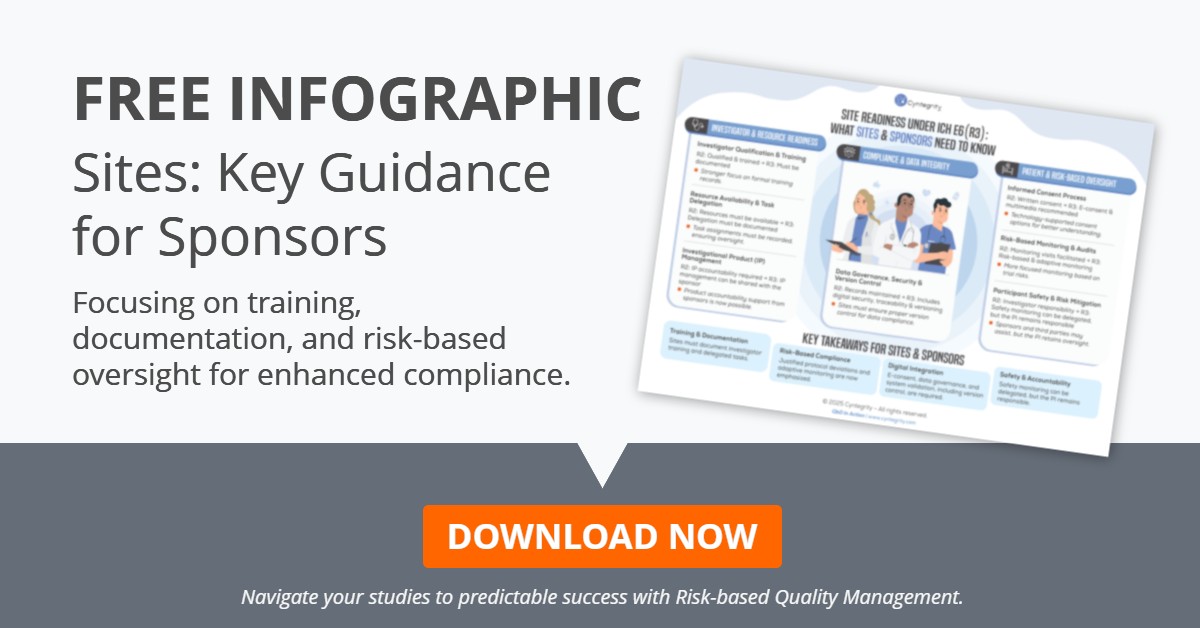[SCROLL DOWN TO GET YOUR INFOGRAPHIC]
Are QTLs and KRIs the Same?
QTLs, KRIs, do you get it?
The release of the long-awaited ICH GCP E6(R2) addendum brought some much-needed clarity to the new, risk-based direction of modern clinical trial conduct and where things might be headed in the coming decades. The practical implementation of the suggested risk-based strategies, on the other hand, sparked confusion among many.

Risk-based monitoring (RBM), or nowadays risk-based quality management (RBQM), methodologies allow for the use of objective data to prospectively and collaboratively identify areas of high-risk so that remediation can be performed to alleviate patient safety issues, data corruption and rapidly rising risk recovery costs before they occur.
Adopting such a risk-based methodology though, goes along with revolutionary digital technology and processes, predictive analytics and associated jargon, e.g., “QTL”, “KRI”, which are all new to the relatively conservative pharma industry. Until recently, one-third of the sponsors and providers indicated having a limited understanding of what is required and how it works.
QTLs and KRIs go hand in hand
Quality Tolerance Limits (QTLs) and Key Risk Indicators (KRIs) are key metrics of risk-based quality management systems. In the context of a holistic risk-based methodology they are not interchangeable, instead, they go hand in hand. Whereas QTLs are planned to identify systematic deviations at study level, KRIs typically trigger risk mitigation actions at site performance level.
The updated Good Clinical Practice guidance dedicates two sections to Quality Tolerance Limits (QTLs) as part of the risk control and risk reporting requirements:
5.0.4 Risk Control: Predefined quality tolerance limits should be established, taking into consideration the medical and statistical characteristics of the variables as well as the statistical design of the trial, to identify systematic issues that can impact subject safety or reliability of trial results. Detection of deviations from the predefined quality tolerance limits should trigger an evaluation to determine if action is needed.
5.0.7 Risk Reporting: The sponsor should describe the quality management approach implemented in the trial and summarize important deviations from the predefined quality tolerance limits and remedial actions taken in the clinical study report (ICH E3, Section 9.6 Data Quality Assurance).
TransCelerate’s Risk-based Monitoring methodology introduces the use of Risk Indicators (RIs), often referred to as Key Risk Indicators (KRIs). The TransCelerate RBM position paper defines KRIs as:
A metric, which controls critical data and study variables with and sets threshold(s) (in many cases by comparing across program/ protocol/ country/ site).
In addition, the position paper defines “Thresholds” as:
The level, point, or value associated with a Risk Indicator that will trigger an action.
…getting confused now?

Graphical examples of KRIs from MyRBQM® Portal
Download your infographic
In an attempt to clear up confusion surrounding the interpretation and use of QTLs and KRIs, we have created an easy to understand infographic for all clinical research experts involved in quality control. Enjoy!
Sources:
NEW | The Clinical Researcher’s Guide to RBQM
Discover the future of clinical research with “The Clinical Researcher’s Guide to RBQM” by Artem Andrianov, PhD, and Johann Proeve, PhD.
This comprehensive guide (160+ pages Kindle edition) explores the principles of risk-based quality management, offering invaluable insights for optimizing clinical trials. Don’t miss your chance to be at the forefront of innovation in biopharmaceutical product development.









